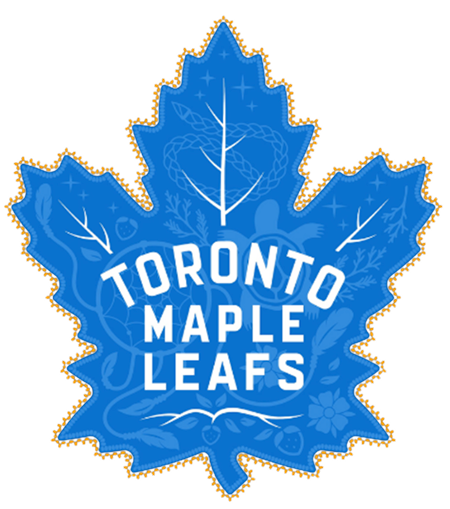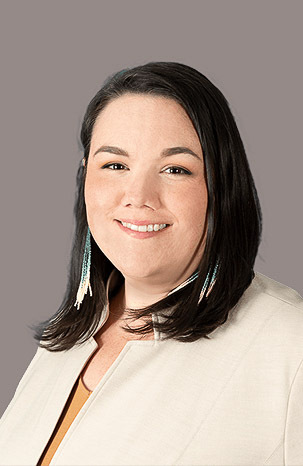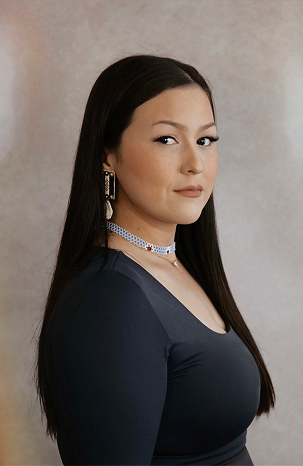



Jennifer Taback is a member of Shawanaga First Nation and Co-CEO at Design de Plume. She sees herself as a visual translator, helping to bridge connections and use emerging technology to facilitate dialogue, increase understanding, and make some cool stuff along the way. Jennifer currently serves the role of listener, advisor, and strategist on projects that venture into new and unknown territories, while acknowledging the experiences and stories of the past.
“It's an exciting opportunity to reimagine such a well-known logo and share my interpretation with both my community and the Maple Leafs' community. As an Anishinaabe-kwe from Shawanaga First Nation, I'm passionate about showcasing our cultural and visual storytelling through design and art our artistic style emphasizes line work and the iconography of meaningful symbols, and it was fascinating to blend both traditional and Western elements. Miigwetch (thank you) for the opportunity to share this with all the fans.”
Story Behind the Logo
This logo is a collection of symbols that reflect my experiences, community, and meaningful stories as an urban Indigenous person. The shades of blue represent the waters of Georgian Bay and the essential role that water plays in our lives and in Northern Ontario. The beaded maple leaf is inspired by my sister, Julia Taback, whose incredible beadwork reflects the style of our community. At the bottom of the leaf, o’demiin (strawberries) grow from the vines, embodying our teachings of Love and the importance of a strong heart to keep the blood flowing. I’ve included two medicines—sweetgrass and cedar—that grow in my family’s yard, along with a dreamcatcher honouring my parents, who have always encouraged me to follow my own path. At the centre is a turtle, representing my clan and Turtle Island, the land we all share.
“This logo is a collection of symbols that reflect my experiences, community, and meaningful stories as an urban Indigenous person. The shades of blue represent the waters of Georgian Bay and the essential role that water plays in our lives and in Northern Ontario.”
Details - “The beaded maple leaf is inspired by my sister, Julia Taback, whose incredible beadwork reflects the style of our community.”
O'DEMIIN- “At the bottom of the leaf, o'demin (strawberries) grow from the vines, embodying our teachings of love and the importance of a strong heart to keep the blood flowing.
MEDICINES & DREAMCATCHER- “I've included two medicines- sweetgrass and cedar-that grow in my family's yard, along with a dreamcatcher honouring my parents, who have always encouraged me to follow my own path.”
TURTLE- “At the centre is a turtle, representing my clan and Turtle Island, the land we all share.”


Luke Swinson is an illustrator and muralist based in Kitchener, Ontario, whose work is rooted in his Indigenous heritage as a member of the Mississaugas of Scugog Island First Nation. With a focus on cultural education and preservation, Luke’s art serves as a personal exploration and reclamation of his heritage. Through his vibrant, thought-provoking pieces, he hopes to inspire younger generations to connect with their roots and the natural world.
Story Behind the Logo
“This was a big one. There’s a lot to say about this design but at the heart of it is Indigenous joy and its many forms. Basketball is integral to so many Indigenous communities across Turtle Island and I really felt the drive to design something Indigenous Raptors fans would be proud of.”
“How could I take such an iconic logo and put my own spin on it? I’m Luke Swinson, I’m an Anishinaabe artist from Kitchener Waterloo, and my community is the Mississaugas of Scugog Island First Nation. I want to use this opportunity to share what I can about my culture and my people, and I think that will encourage other Indigenous folks to get involved, and to play basketball, and to get their voices heard and share their stories”


Emily Kewageshig is an Anishinaabe artist and visual storyteller from Saugeen First Nation No. 29. With a deep-rooted connection to her heritage, her artwork explores the intricate interconnection of life forms, weaving together both traditional and contemporary materials.
Her creative practice is centered around the cyclical themes of birth, death, and rebirth - concepts that have profound significance in both her cultural teachings and personal lived experiences.
In 2020, Emily celebrated her first solo exhibition titled "Mooshknemgog Bmaadziwin: Full Circle," showcased at the Tom Thomson Art Gallery in Owen Sound, Ontario. This milestone marked a significant moment in her career, highlighting the intersection of her artistic expression with her Indigenous roots. Emily continues to produce artwork for a wide array of organizations, using her art as a tool to elevate and honour Indigenous knowledge, culture, and identity.
Emily's journey as an artist is one of resilience and determination. Leaving her home reserve at the age of 17, she moved to Toronto with aspirations of pursuing higher education and making a living through her passion for creating art. After graduating with Honours from Sheridan College’s Visual and Creative Arts Diploma program in 2017, where she was awarded “Best in Show” at the final graduate exhibition. Emily continued her studies at OCAD University in the BFA Indigenous Visual Culture program (2017-2020). Her experiences as a mother, especially after becoming a parent in 2018, inspired her to reflect on the cyclical nature of life - a concept deeply rooted in her Anishinaabe worldview. She believes that life is a never-ending circle, where everything is interconnected and flows with balance and harmony.
As an artist, Emily's work draws on vivid colours, bold graphic lines, and a combination of traditional and contemporary materials. Each piece captures the delicate balance between culture, identity, and the cycles of life, illustrating how each plant, animal, and person plays an essential role in the sustainability of our ecosystems for future generations.
Emily is not only an artist but also a role model and advocate for Indigenous youth across Turtle Island. Through her work, she continues to inspire and educate, fostering a deeper understanding of Indigenous perspectives. Her commitment to her craft and cultural heritage has led her to collaborate with renowned organizations and brands, including CBC, DavidsTea, Manitobah Mukluks, Globe and Mail, Toronto Argonauts, Redken, Purolator, Parks Canada, NBC Universal, and MiniTipi. Her work has been highlighted nationally by APTN and CBC news.
She is also the illustrator of three notable books: Walking Together, With Our Orange Hearts, and Of the Sun. Additionally, Emily has created many murals across Toronto, Ontario, infusing public spaces with Indigenous art that serves as a visual celebration of her culture and teachings.
As an Artist Ambassador with the Gord Downie & Chanie Wenjack Foundation, Emily uses her platform to raise awareness and encourage reconciliation between Indigenous and non-Indigenous communities. She was featured in a short film by National Geographic titled Flowing through Ontario’s Many Wonders of Water, where she highlighted the importance of preserving water sources and championing Indigenous rights as an advocate for environmental sustainability.
Through her work, Emily continues to connect past, present, and future, ensuring that the knowledge and beauty of Indigenous cultures remain vibrant and resilient for generations to come. sponding to the Truth and Reconciliation Commissions’s 94 Calls to Action.